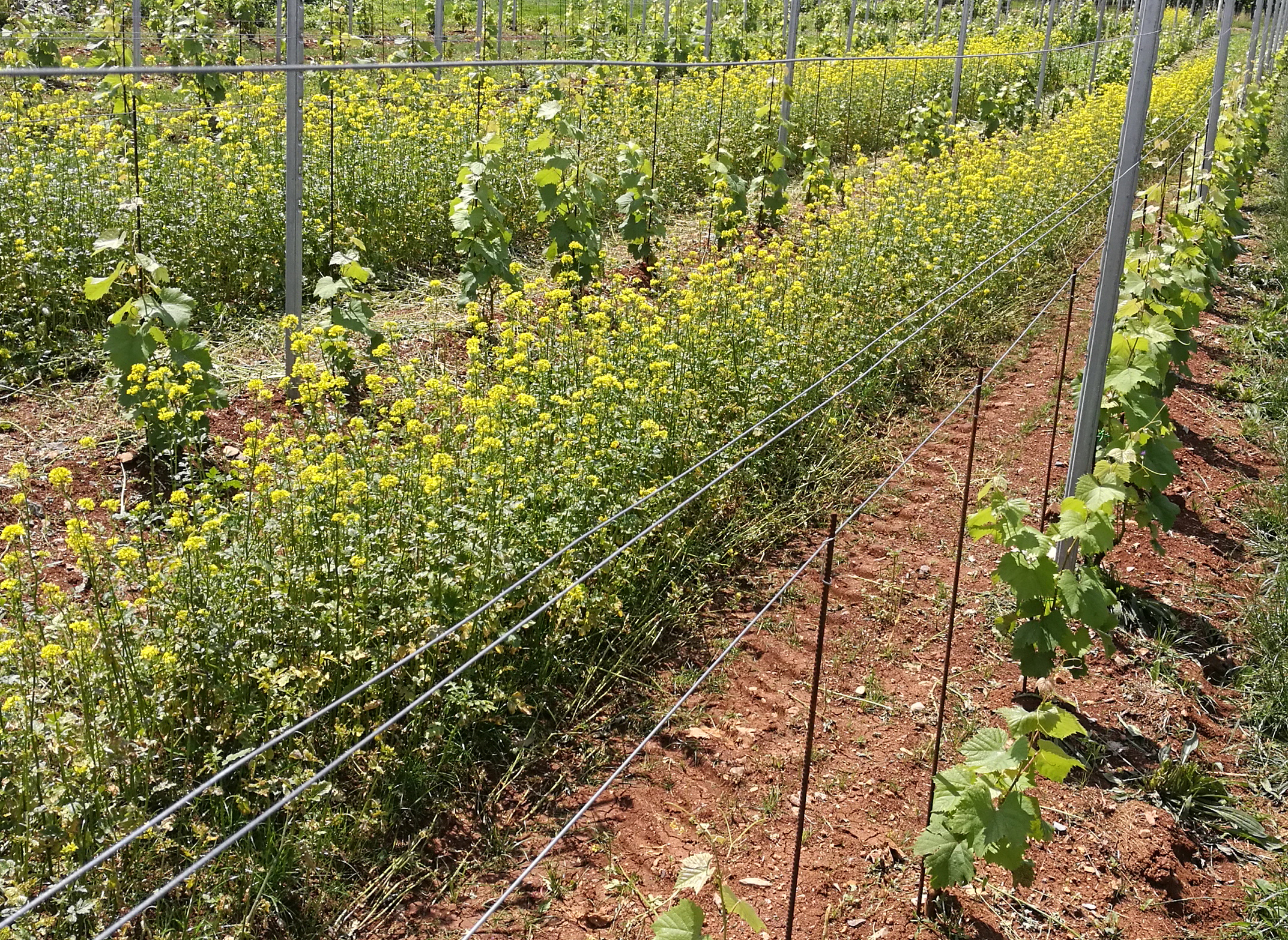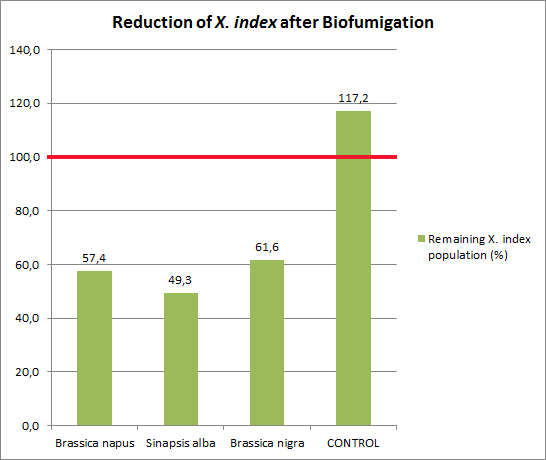Brassica cover crops can reduce nematode pests
The possibility of controlling soil-borne pest nematodes by using Brassica* species. plants as cover crops in the inter-row space of vineyards followed by biomass incorporation and so called biofumigation was investigated in the CORE Organic Cofund project BIOVINE.


The most devastating nematodes associated with grapevines are the dagger nematodes of Xiphinema genus, in particular the species Xiphinema index. The economic impact of Xiphinema on grapevines is mainly due to the association with specific viruses, transmitted from plant to plant through nematode feeding on roots. Thus, in particular, the highly relevant impact of X. index is due to its activity as vector of Grapevine fanleaf virus (GFLV), one of the most important viruses of the grapevine. The efficient management options of nematode infested vineyards are very limited mainly because of perineal nature of the grapevine, the nematodes’ longevity and their vertical distribution as deep as a few meters in the soil. Crop rotation and fallow periods are currently the most efficient management approaches, though not economically viable because of the long period (7–10 years) needed before vineyard replanting.
In the BIOVINE project (www.biovine.eu) management options for the soil-borne pest nematode Xiphinema index were investigated by using Brassica plants as cover crops in the inter-row space. Brassica species plants, including Brassica nigra, Brassica napus and Sinapis alba, are known for their rapid growth, great biomass production, and nutrient scavenging ability. Brassica species release chemical compounds that can be toxic to soil borne pests; mustards usually have higher concentrations of glucosinolates and other secondary plant compounds than other plants.
The experimental vineyard was set up on a X. index-infested plot in Slovenia. The nematode population size was assessed by soil sampling to the depth of 30 cm, nematode extraction from the soil samples and X. index quantification using stereo microscope. Cover crops were sawn in April into the inter-row space and grown until the end of June when they were mulched and incorporated into the soil. The biofumigation** took place during the hot summer months of July and August. After biofumigation period X. index population was assessed again.
The results showed significant reduction of X. index nematode population on biofumigated plots compared to initial population. Sinapis alba reduced the X. index population for approximately 50 percent compared to the initial population size while biofumigation with Brassica napus and Brassica nigra decreased the nematode population to 57 percent and 61 percent of the initial population size, respectively. On the control plot (without cover crops and biofumigation), the population of the X. index increased to 117 percent compared to the initial population.
The experiments showed that Brassica cover crops used as biofumigant crops could reduce X. index nematode pests in the upper soil layer (up to 30 cm depth) however, more than half of the initial nematode population remained in the soil. This approach can be advised to the farmers in addition to the management options of crop rotation and fallow periods which may shorten the period needed before vineyard replanting. However, the soil should be tested to confirm absence of the Xiphinema spp. nematodes before replanting.
In addition, testing of biofumigation in combination with beneficial microorganisms as an amendment at replanting stage for X. index management are still ongoing at the experimental plot. Further, testing of additional treatment for X. index management is in progress; biofumigation combined with beneficial microorganism added at the replanting stage. These results will be available at the end of the BIOVINE project.
* Brassica is a genus of plants in the mustard family (Brassicaceae). The members of the genus are informally known as cruciferous vegetables, cabbages, or mustard plants.
**Biofumigation is an agronomic practice that consists of finely grinding a plant cover set up during the fallow period and incorporate the chopped biomass into the soil
Relevant links
BIOVINE project website, www.biovine.eu
Bello, A., Arias, M., Lopez-Perez, J. A., Garcia-Alvarez, A., Fresno, J., Escuer, M., Arcos, S. C., Lacasa, A., Sanz, R., Gomez, P., Diez-Rojo, M. A., Buena, A. P., Goitia, C., de la Horra, J. L., and Martinez, C. (2004). Biofumigation, fallow, and nematode management in vineyard replant. Nematropica 34:53-64.
Ferris, H. & McKenry, M.V., (1976). Nematode community structure in a vineyard soil. J. Nematol. 8 131-137.
Monfort, W.S., Csinos, A.S., Desaeger, J., Seebold, K., Webster, T.M. & Diaz-Perez, J.C., (2007). Evaluating brassica species as an alternative control measure for root-knot nematode (M. incognita) in Georgia vegetable plasticulture. Crop Prot. 26, 1359-1368.
Zasada, I.A. & Ferris, H.,(2004). Nematode suppression with brassicaceous amendments. Soil Biol. Biochem. 36, 1017-1024.
Authors
Saša Širca, Kmetijski inštitut Slovenije (Agricultural Institute of Slovenia), sasa.sirca@kis.si https://www.kis.si/en/Plant_Protection_Department/
Barbara Geric Stare, Kmetijski inštitut Slovenije (Agricultural Institute of Slovenia), barbara.geric@kis.si https://www.kis.si/en/Plant_Protection_Department/
Nik Susič, Kmetijski inštitut Slovenije (Agricultural Institute of Slovenia), nik.susic@kis.si https://www.kis.si/en/Plant_Protection_Department/
Melita Theuerschuh, Kmetijski inštitut Slovenije (Agricultural Institute of Slovenia), melita.theuerschuh@kis.si https://www.kis.si/en/Plant_Protection_Department/
Editor: Karin Ullven / Design: Christine Dilling
